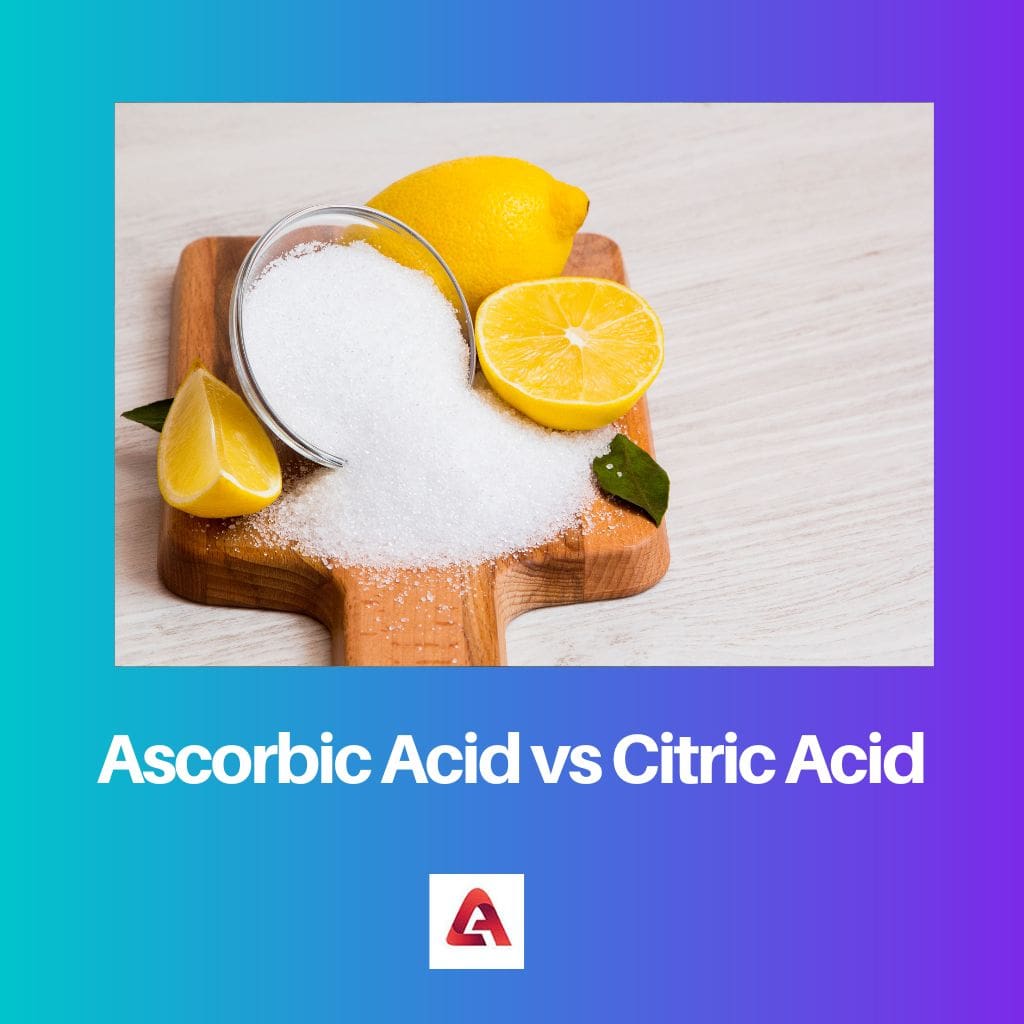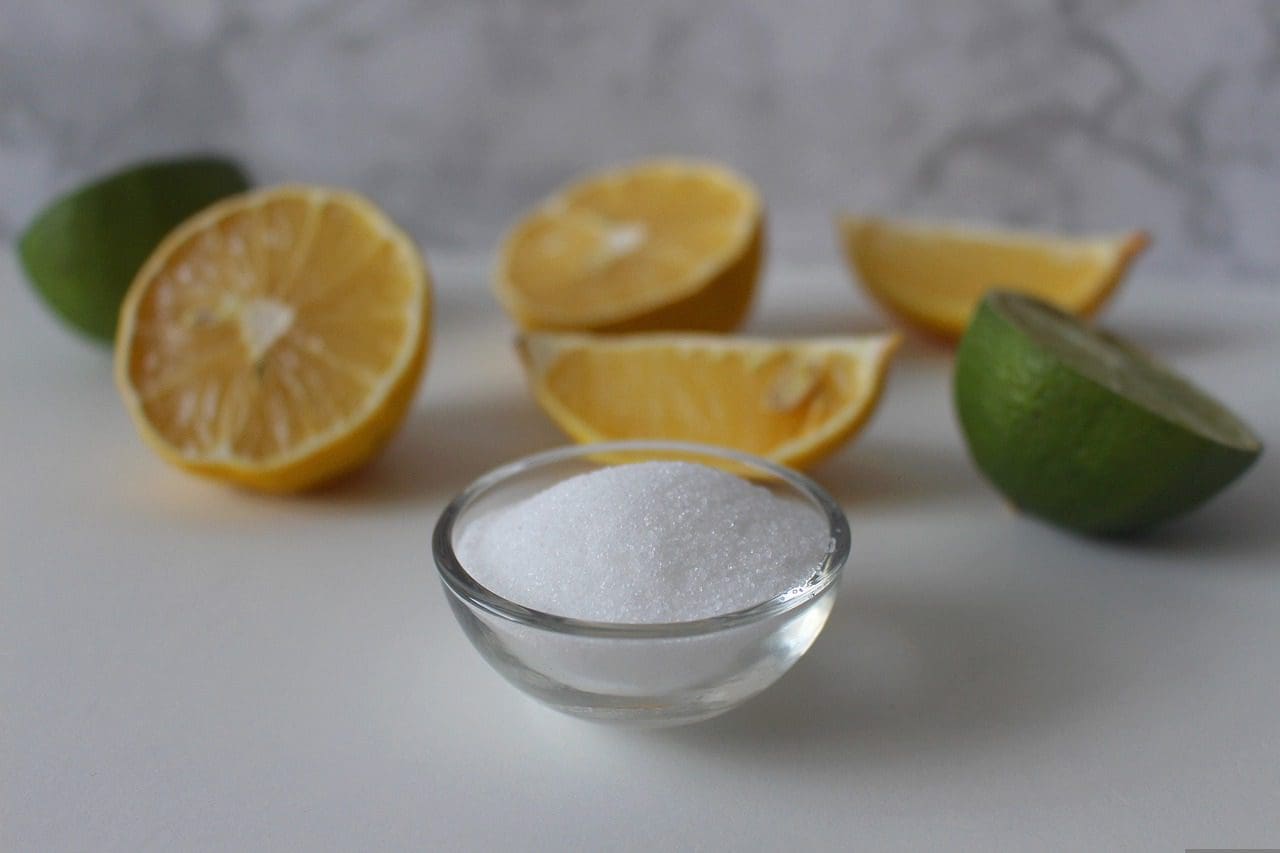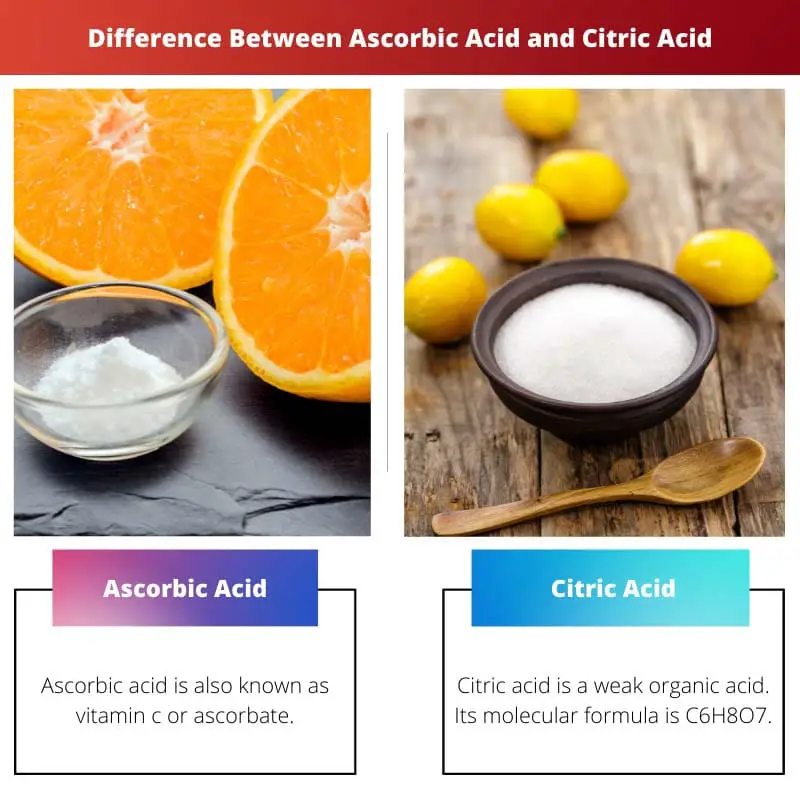Ascorbic acid, commonly known as vitamin C, is a potent antioxidant crucial for collagen synthesis, immune function, and wound healing. Citric acid, found naturally in citrus fruits, is a weak organic acid widely used as a flavoring agent and preservative in food and beverages, also serving as a chelating agent in cleaning products.
Key Takeaways
- Ascorbic acid is a type of vitamin C essential for developing, developing, and repairing body tissues.
- Citric acid is a weak organic acid commonly found in citrus fruits and is used as a natural preservative and flavor enhancer in food and beverages.
- Ascorbic acid is a water-soluble vitamin easily absorbed by the body, while citric acid is used primarily for its acidic properties.
Ascorbic Acid vs Citric Acid
The difference between ascorbic acid and citric acid is that ascorbic acid is a great preservative; hence, it prevents blackening in fruits and vegetables. On the other hand, citric acid is a great additive; therefore, it is added to a supplement for its tart and tangy flavor.

Ascorbic acid is a natural substance. It is also known as vitamin C or ascorbate. They are found in several food items, like citrus fruits.
They are highly beneficial for the body as it boosts the immune system of the body. Citric acid is manmade.
It is synthetically produced. It is a great source of additives and is used in fruit-flavored candies and soda.
It is also a very good cleaning and chelating agent.
Comparison Table
| Feature | Ascorbic Acid (Vitamin C) | Citric Acid |
|---|---|---|
| Chemical formula | C6H8O6 | C6H8O7 |
| Function | Essential vitamin | Organic acid |
| Benefits | – Supports immune function [1, 2] <br> – Promotes collagen production [2] <br> – Acts as an antioxidant [1, 2] | – Enhances flavor [3] <br> – Acts as a preservative [3] <br> – Chelating agent (binds metals) [3] |
| Natural sources | Citrus fruits, berries, leafy greens [4] | Citrus fruits, berries, pineapples [4] |
| Food uses | – Fortified foods (juice, cereals) [5] <br> – Dietary supplement [5] | – Acidulant in beverages and foods [3] <br> – Anti-browning agent in fruits and vegetables [3] |
| Water solubility | Highly soluble | Highly soluble |
| pH | Slightly acidic (around 3.5) | More acidic (around 3.1) |
| Effect on taste | Sour (tart) | Sour (tart) |
| Safety | Generally safe when consumed in moderate amounts. High doses can cause side effects [6]. | Generally safe in small amounts, but high doses can irritate the skin and mucous membranes [7]. |
What is Ascorbic Acid?
Ascorbic acid, also known as vitamin C, is a water-soluble vitamin and essential nutrient for humans and certain other animals. It is a crucial micronutrient that plays several important roles in the body’s functioning.
Chemical Structure and Properties
- Chemical Formula: C₆H₈O₆
- Structure: Ascorbic acid is a six-carbon lactone ring with two hydroxyl groups attached. It exists in two enantiomers, L-ascorbic acid (the biologically active form) and D-ascorbic acid.
- Solubility: Highly water-soluble, which means it dissolves easily in water but is not soluble in lipids (fats).
- Stability: Ascorbic acid is sensitive to heat, light, and air, leading to degradation over time. This degradation reduces its potency and effectiveness.
Biological Functions
- Antioxidant Activity: Ascorbic acid is a potent antioxidant, protecting cells from oxidative stress caused by free radicals. It scavenges free radicals and reactive oxygen species, reducing the risk of cellular damage and inflammation.
- Collagen Synthesis: Vitamin C is essential for the biosynthesis of collagen, a structural protein crucial for the integrity of connective tissues, skin, bones, and blood vessels. It serves as a cofactor for enzymes involved in collagen synthesis, such as prolyl and lysyl hydroxylases.
- Immune Function: Ascorbic acid supports immune function by enhancing the activity of immune cells, such as T-cells and phagocytes. It also promotes the production of cytokines and antibodies, aiding in the body’s defense against infections.
- Wound Healing: Vitamin C plays a vital role in wound healing by stimulating collagen formation, facilitating tissue repair, and promoting the synthesis of connective tissue proteins.
Dietary Sources and Requirements
- Natural Sources: Citrus fruits (e.g., oranges, lemons), strawberries, kiwi, bell peppers, broccoli, and other fruits and vegetables are rich sources of ascorbic acid.
- Dietary Requirements: The recommended dietary allowance (RDA) for vitamin C varies with age, gender, and specific health conditions. For adults, the RDA ranges from 75 to 90 milligrams per day.
Deficiency and Toxicity
- Deficiency: Prolonged inadequate intake of vitamin C can lead to scurvy, a condition characterized by fatigue, weakness, gum disease, and impaired wound healing.
- Toxicity: Excessive intake of ascorbic acid through supplementation may cause gastrointestinal discomfort, diarrhea, and in some cases, kidney stones. However, toxicity from dietary sources is rare due to the body’s efficient regulation of vitamin C absorption.

What is Citric Acid?
Citric acid is a weak organic acid found naturally in citrus fruits like lemons, oranges, limes, and grapefruits. It is widely used in various industries due to its acidic and chelating properties, as well as its ability to enhance flavors and preserve food products.
Chemical Structure and Properties
- Chemical Formula: C₆H₈O₇
- Structure: Citric acid is a tricarboxylic acid, meaning it has three carboxylic acid functional groups. It exists as a white crystalline powder at room temperature.
- Solubility: Highly water-soluble, making it easy to dissolve in water.
- Acidity: Citric acid is a weak acid, with a pH around 2.2, making it less acidic compared to strong mineral acids like hydrochloric acid.
Industrial and Culinary Applications
- Food and Beverage Industry: Citric acid is extensively used as a flavoring agent, preservative, and pH regulator in the food and beverage industry. It adds a sour or tangy taste to products and enhances flavors in various foods, including beverages, candies, jams, and sauces. Additionally, it acts as a preservative by inhibiting microbial growth and oxidation, thereby extending the shelf life of processed foods.
- Pharmaceuticals and Cosmetics: Citric acid is utilized in pharmaceuticals and cosmetics as a pH adjuster, buffering agent, and chelating agent. It helps maintain the stability and efficacy of formulations and can also be found in skincare products, shampoos, and personal care items.
- Cleaning Products: Due to its chelating properties, citric acid is used in cleaning products, such as detergents and household cleaners, to remove mineral deposits, scale, and rust stains from surfaces. It acts by binding to metal ions, preventing them from reacting with other components and facilitating their removal.
Health and Safety Considerations
- Dietary Consumption: While citric acid is recognized as safe (GRAS) for consumption in moderate amounts, excessive intake may cause gastrointestinal discomfort in some individuals.
- Allergies and Sensitivities: Some people may experience allergic reactions or sensitivities to citric acid, although this is relatively uncommon.
- Environmental Impact: Citric acid is biodegradable and considered environmentally friendly compared to many synthetic alternatives. However, its production process may involve energy-intensive steps, and disposal of large quantities may impact aquatic ecosystems.
- Regulatory Status: In many countries, including the United States and European Union, citric acid is approved for use in food, beverages, pharmaceuticals, and cosmetics, subject to specific regulations and maximum permitted levels.
Commercial Production
- Fermentation: The primary method for commercial production of citric acid involves fermentation of carbohydrates by certain microorganisms, such as Aspergillus niger or Candida spp. Glucose or sucrose-rich substrates like molasses or corn steep liquor are commonly used as fermentation feedstocks.
- Extraction: Citric acid can also be extracted from natural sources, particularly citrus fruits, using processes such as extraction, purification, and crystallization.

Main Differences Between Ascorbic Acid and Citric Acid
- Chemical Composition:
- Ascorbic acid: Chemical formula C₆H₈O₆, a monoprotic organic acid with antioxidant properties.
- Citric acid: Chemical formula C₆H₈O₇, a tricarboxylic acid with weak acidic properties, commonly found in citrus fruits.
- Biological Functions:
- Ascorbic acid: Essential nutrient for humans, crucial for collagen synthesis, immune function, and antioxidant defense.
- Citric acid: Primarily utilized as a flavoring agent, preservative, and pH regulator in food and beverages, with minimal biological activity in the body.
- Sources and Dietary Requirements:
- Ascorbic acid: Found in various fruits and vegetables, with dietary requirements varying based on age, gender, and health status.
- Citric acid: Naturally present in citrus fruits and widely used in processed foods, beverages, and cleaning products, with no specific dietary requirement for humans.
- Functional Use:
- Ascorbic acid: Plays a vital role in human health as a nutrient and antioxidant, supporting collagen formation, immune function, and wound healing.
- Citric acid: Primarily serves industrial purposes in food processing, pharmaceuticals, cosmetics, and cleaning products, enhancing flavors, extending shelf life, and facilitating cleaning processes.

- https://www.nejm.org/doi/pdf/10.1056/NEJM198604033141407
- https://www.sciencedirect.com/science/article/pii/S0304416501002355
- https://pubs.acs.org/doi/pdf/10.1021/ie50463a008
- https://books.google.com/books?hl=en&lr=&id=43W1BQAAQBAJ&oi=fnd&pg=PP6&dq=citric+acid&ots=FFXWeqvEFa&sig=5AKetwR5f1PXC3si15YajNXhOFs




